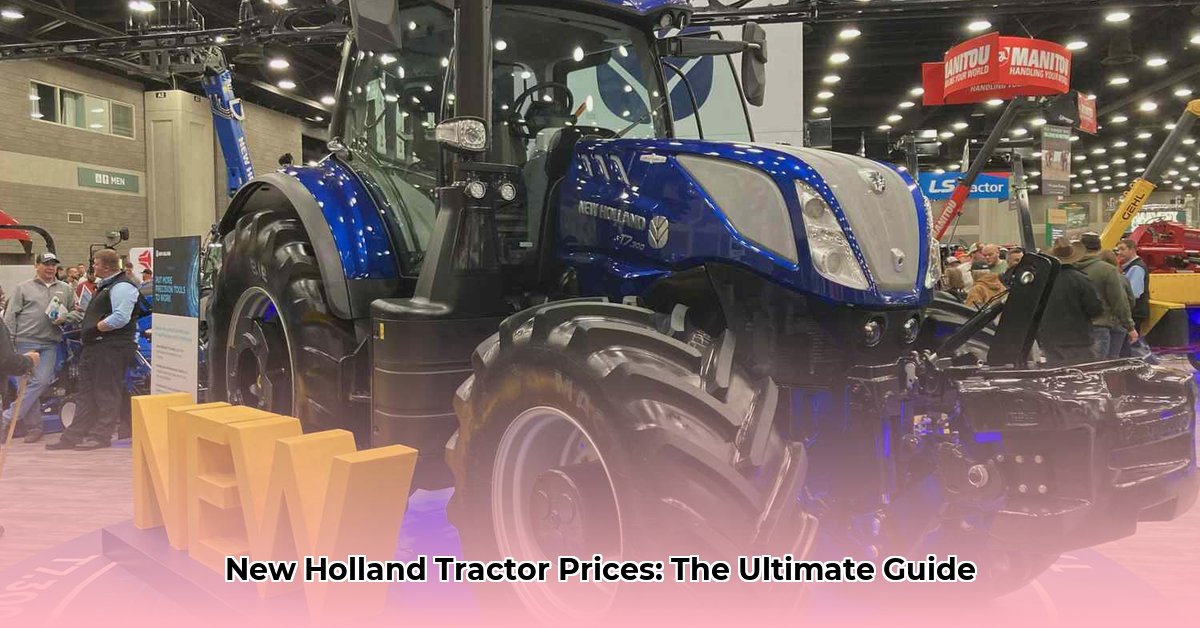
Investing in a new tractor is a significant decision for any farmer, representing a substantial financial commitment and a long-term investment in the future of their operation. This guide explores the price range of New Holland tractors, factoring in the increasingly important role of sustainable technologies in modern agriculture. While the initial cost can be high, the long-term benefits—both financial and environmental—often justify the expense. For more tractor price comparisons, see this helpful resource: Tractor Price Guide.
Decoding New Holland Tractor Prices: A Range of Options
The price of a new New Holland tractor is highly variable, spanning a broad spectrum depending on several key factors. Horsepower, model features, and optional equipment all dramatically impact the final cost. Think of it like choosing a car – a basic model is far cheaper than a luxury vehicle loaded with advanced features. Similarly, a smaller, less-equipped New Holland tractor will cost significantly less than a high-horsepower model equipped with advanced technology. We're talking a range from tens of thousands to well over half a million dollars.
Here's a general price range based on horsepower:
| Horsepower Range | Approximate Price Range (USD) |
|---|---|
| 40-60 HP | $40,000 - $70,000 |
| 70-90 HP | $70,000 - $100,000 |
| 100-120 HP | $100,000 - $150,000 |
| 120+ HP | $150,000+ |
Note: These prices are estimates. Actual costs will vary depending on location, dealer, specific model features, and any additional equipment. Always contact your local New Holland dealer for precise pricing information on the models and configurations you are considering.
The Value of Sustainable Technology: Beyond the Initial Investment
Sustainable agricultural practices are increasingly crucial, and New Holland offers a range of tractors incorporating advanced technologies designed for enhanced efficiency and reduced environmental impact. These features, such as Precision Land Management (PLM) systems and alternative fuel capabilities, often command a higher upfront cost. However, the long-term benefits can significantly outweigh this initial investment.
PLM systems, for example, optimize fuel consumption, reduce fertilizer use, and minimize waste, leading to substantial savings over the tractor's lifespan. Furthermore, the environmental advantages of reducing reliance on fossil fuels contribute to a more sustainable agricultural model. But is the premium worth it? A thorough cost-benefit analysis, considering both short-term and long-term impacts, is crucial for making an informed decision that aligns with the specific needs and financial situation of the farmer.
How to Finance Your Sustainable Farming Investment: Practical Steps
Securing financing for a new tractor is a critical step in the process. Here are several viable options:
Traditional Farm Loans: Explore loans offered by banks and credit unions specializing in agricultural financing. Compare interest rates and loan terms to find the most favorable option.
Leasing: Leasing can provide a more manageable financial path, especially for smaller farms. This approach reduces upfront costs and offers flexibility in the long run.
Government Subsidies and Grants: Research federal, state, and local programs designed to encourage the adoption of sustainable agricultural practices. This can significantly reduce the net cost of a new tractor.
CNH Capital: New Holland's dedicated financing arm offers a variety of tailored options for farmers. Check their website (https://agriculture.newholland.com/en-us/nar/services-and-solutions/financing) for details.
Private Investment: Explore the possibility of attracting private investors interested in supporting sustainable agricultural initiatives.
Remember: A well-structured business plan demonstrating the long-term return on investment (ROI) from sustainable technologies greatly strengthens your financial application.
Success Stories: Real-World Examples of Sustainable Farming
Many farmers have successfully integrated sustainable New Holland technologies into their operations, demonstrating that the upfront cost is often justified by long-term benefits. These success stories highlight the importance of thorough planning, financial prudence, and networking within the agricultural community. Learning from experienced farmers who have navigated similar financial challenges is invaluable.
Conclusion: Choosing the Right Tractor for Your Farm
The decision of whether or not (and how) to purchase a new tractor should be a well-informed one, carefully weighing the financial considerations against the potential long-term benefits. Consult with your local New Holland dealer, thoroughly analyze your financial situation, and investigate all available financing options. The long-term success of your farm may depend on it.